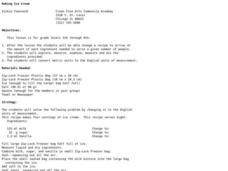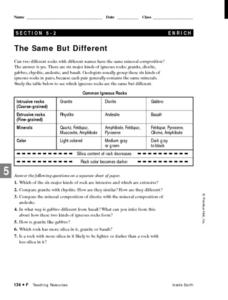Curated OER
Dry Ice: Simply Sublime
A fascinating lesson on states of matter is here for your young scientists. Dry ice is used to challenge learners preconceived notions about how solids work. They discover all sorts of interesting facts about states of matter from...
Curated OER
Dry Ice Activities Mini Lesson
Get your middle schoolers experimenting with dry ice. In the first activity, they place a piece in water and then use phenol red to identify its pH. In the second, they place a piece in a limewater solution and watch as the combination...
Micron Technology Foundation
States of Matter
Solids, liquids, gasses oh my! Young scientists will be amazed when they try this experiment, which uses dry ice to discover the states of matter through sublimation.
Curated OER
States of Matter
Students discuss a given set of questions based on Chemistry and matter and review a glossary of terms. They conduct experiments on each state of matter: "Dry ice and water, Dry ice and soap and Dry ice and Isopropyl Alcohol." and...
Science Friday
Sublime Sublimation
Dry ice isn't dehydrated water, and young scientists learn why in this fascinating presentation. After watching a video, they complete three different activities using dry ice. Upon completion, they discuss the scientific principle.
Curated OER
Making Ice Cream
Students explore the concept of making ice cream. For this ice cream lesson, students convert an ice cream recipe from metric units to English units. Students then make ice cream from the recipe they converted.
Curated OER
Boot Reer Root Beer
Fifth graders investigate chemical reactions. In this physical science activity, 5th graders make dry ice root beer and identify the type of change that occurs to the root beer mixture.
American Chemical Society
Changing State: Melting
Dry ice is extremely cold — it is -109.3°F or -78.5°C. Scholars observe and explain the molecular motion associated with melting. Then they design their own experiments to speed up the melting process. Finally, a teacher presents a...
Curated OER
Cookin' Up a Comet
Young scholars view a teacher demonstration of comet composition. In this comet science lesson, students watch as the teacher combines sand, ammonia, cola, and dry ice to simulate the composition of a comet. They answer discussion...
Curated OER
States of Matter
Students study the states of matter. In this matter lesson, students use dry ice to study the states of matter. Students observe and answer questions based on the material.
Curated OER
Negative and Positive Numbers
Help scholars explain the concept of positive and negative numbers. Here you will find three separate activities that will help them to correlate positive and negative numbers with real life. Note: Activities require that the teacher...
Curated OER
Melt the Ice
Young scholars examine and discuss how water changes from a liquid to a solid to a gas. They explore this concept by having an ice cube race, competing to see which group can change the solid water back into liquid water first.
American Chemical Society
Exploring Moisture on the Outside of a Cold Cup: For Dry Environments
If the area you live in is arid, or the preceding experiment in this unit didn't yield obvious results, use this one in place of it to help reveal where condensation comes from. The mini unit that this is part of a comprehensive...
Curated OER
It's The States of Matter
Students investigate the properties of solids, liquids and gases. In this states of matter lesson plan, students observe dry ice and its characteristics. They calculate the density of dry ice and observe the sublimation of the dry ice...
Curated OER
Making a Comet in the Classroom
Students study comets and how Halley's comet was created. In this space lesson students create their own comets using dry ice.
Curated OER
The Chemistry of Bigger Bubbles
Fourth graders explore properties of bubbles. In this instructional activity about bubbles, 4th graders perform an experiment. Students analyze the properties of bubble making substances and surface tension. Students create a square...
Curated OER
Crystal Ice Art
This isn't just an art lesson, it's a science lesson too. Kids draw a lovely winter scene and then paint over it with a solution of epsom salts and water. They make predictions, then observe how crystals form as the water evaporates...
National Wildlife Federation
Wherefore Art Thou, Albedo?
In the sixth lesson in a series of 21, scholars use NASA data to graph and interpret albedo seasonally and over the course of multiple years. This allows learners to compare albedo trends to changes in sea ice with connections to the...
Curated OER
Activity #14 Floating Bubbles
Young scholars comprehend that Carbon dioxide gas is relatively easy to generate. They comprehend that one way to produce it is with dry ice. Pupils comprehend that carbon dioxide gas can also be produced by combining baking soda with...
Curated OER
States of Matter
Learners explore the states of water. In this physical science lesson, students use ice and dry ice to observe the changes in the state of matter. Learners record the results.
Curated OER
Comets and Meteors
Learners construct a model of a comet nucleus using dry ice. They add other materials and describe the features. They complete related exercises on an Internet Web site.
Polar Trec
Do Microorganisms Live in Antarctica?
Can microorganisms live in the dry, cold climate of Antarctica? Young scientists view a research project measuring microorganisms in the Taylor Glacier. They record the findings from dirty ice, clean ice, boots, sediment, and more. Then...
Curated OER
The Same, But Different
Third graders examine the phase change between solids and liquids and determine it to be a physical change. Ice is the perfect item to use to demonstrate this phase change. Pupils experiment with measuring and weighing solid ice and the...
PBS
The Chrysalis or Pupa
What is one of the most exciting parts of a butterfly's life cycle? When it emerges from its pupa and dries its wings! This is a great activity little ones will love. They discuss what happens during the pupal stage of the butterfly life...
Other popular searches
- Dry Ice Experiments
- Sublimation Lab Dry Ice
- Dry Ice Video
- Dry Ice Activity
- What Is Dry Ice
- Dry Ice Lab
- Using Dry Ice
- Dry Ice Co2
- Dry Ice Ice Cream
- Dry Ice With Peroxide
- Dry Ice and Sublimation
- Dry Ice Halloween

























